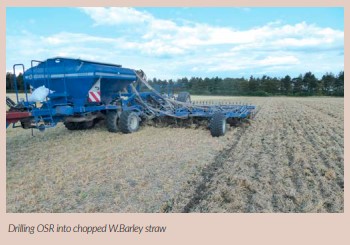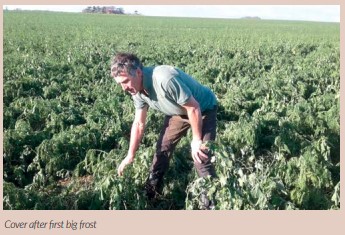
I was not sorry to see the end of harvest 2021. A combination of low yielding OSR, a large acreage of Firefly wheat that broke down to Septoria, disappointing Extase yields and spring barley that was flattened by August rains meant that it was not a vintage year for us. Luckily prices have compensated to a large extent but it rams home the message that with potentially increasingly volatile weather patterns leading to less predictable harvest outcomes it is vitally important to minimise the reliance on purchased inputs and maximise the crop growth benefits to be had (free) from fully functioning natural ecosystems.
The input reduction message is especially pertinent with the present high Nitrogen prices. I have been uneasy for a long while about the high level of environmentally damaging Nitrogen inputs going onto my crops and advocate that minimising the use of synthetic N should be the fifth pillar of Regen. Ag. to sit alongside the other four that are usually quoted. Unfortunately as a Farm Manager tasked with maximising business profitability it has always been a difficult decision to unilaterally reduce fertiliser inputs and potential profit margins.
For a number of years now I have supported the idea of a Nitrogen tax or Quota (Tin hat on!) so that we are all on a level playing field, but the idea has never really gained any serious traction. The present high prices have however effectively done this in the short term and I am excited at the prospect of finally being able to grow our harvest 2022 crops with significantly lower N levels and the challenge of maximising N use efficiency, plant nutrition etc to compensate.
Our 10 m Kockerling tine drill continues to give us sterling service. It is particular good at coping with my masochistic tendency to plant crops behind silly amounts of chopped straw (particularly winter and spring barley) It also gives remarkably even establishment considering that it is rigid front to back and left to right with no contour following. (This is partly due to the fact that for most situations, apart from when we use it to direct drill OSR after wheat, we have used it after combining to create a shallow stale seedbed. This creates a “ bottom” to the seedbed and when we return to the field for the drilling pass there is virtually no tine chatter.).

Unfortunately it moves a lot of soil so we get a second blackgrass chit during the drilling pass and even with a big pre-em stack we are not getting 100% control. Consequently we are not eradicating blackgrass but merely standing still with annoying levels which are not low enough to be hand roguable. For this reason and the fact that the drill doesn’t work so well in spring after cover crops I am convinced that we now need to purchase a low disturbance disc drill so that we have the capability to use discs or tines as appropriate. At this time of the year I am busy in the office doing budgets, cashflows and accounts analysis and my thoughts have been turning to other machinery investments that may be needed to help us move our farming system forwards and unfortunately it all comes to an eye watering amount of money!
In particular I have been pondering the techniques that will be needed if and when Glyphosate is banned and have come to the conclusion we will need a plough for occasional shallow rotational complete inversion.We will also need a shallow disc cultivator which will cut 100% of the soil surface at extremely shallow working depth to enable mechanical stale seedbed destruction. I also have a Hoe on my shopping list which will obviously allow mechanical weeding if weed resistance and loss of herbicides make this necessary.

More excitingly though it will allow us to continue to experiment with clover understoreys and could facilitate early planting of cover crops in late spring in growing cash crops during a last hoeing pass with a seeder unit on board. This last possibility is a particular interest for me : Our farming system relies on photosynthesis to build soil carbon (rather than manures or composts) and I am always painfully aware of the wasted sunshine during July, August and September. If we could establish cover crops in growing cereals in late spring they would hopefully germinate (if sowing timed effectively with rain events) and sit in the base of the crops ready to quickly grow after harvest when the competition is removed and therefore utilise the summer sunshine more effectively. It will probably need a fair bit of experimentation to work out the best species/species mix and may even involve the need to buy a stripper header if it results in a lot of green material in the base which interferes with a conventional header.

As I said it is all a big scary shopping list!
Meanwhile back in the fields I have been assessing the successes and failures of our ongoing Cover crop experimentation (Over the last 6-8 yrs we have tried virtually every species and combination of) Traditionally we have grown high biomass multi species mixes for sheep grazing but after the last two wet winters I think that poaching damage may be giving us negative yield affects in following direct drilled spring barley crops.I have therefore started to try lower biomass mixes in some fields that can be partially destroyed by frost/rolling instead of grazing. I have been very impressed this year with the Hutchinsons maxi cover mix which has a nice range of species and has provided a useful cover but which is already starting to die back after a couple of strong frosts recently.
